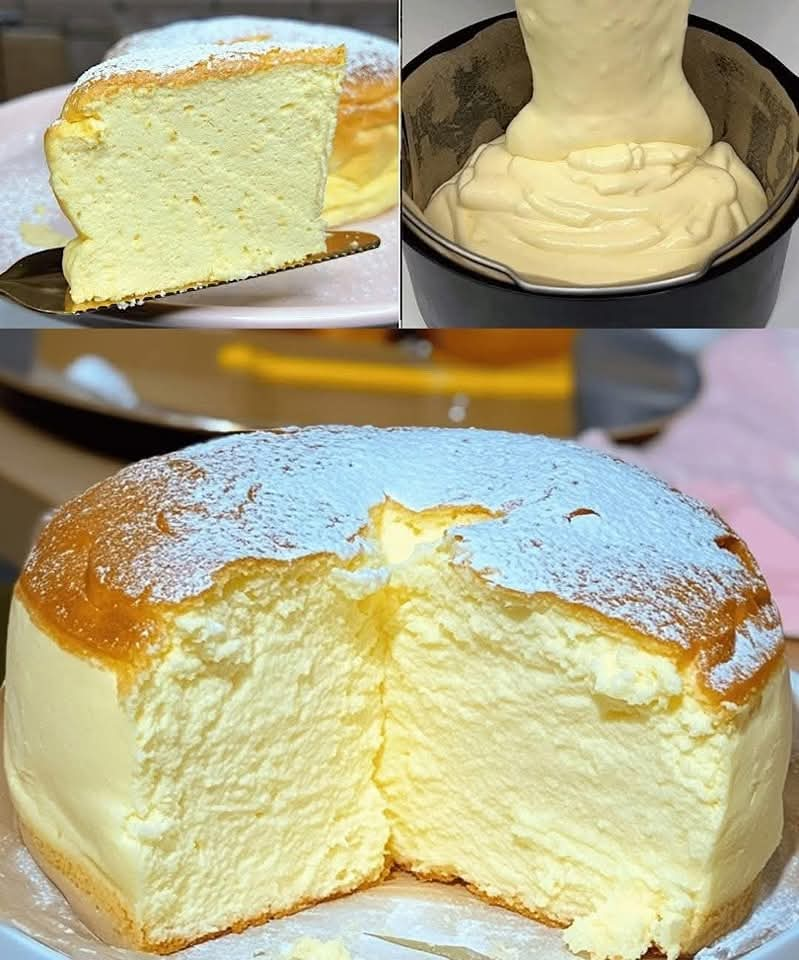Here’s a complete and detailed recipe guide for Japanese Cheesecake, also known as Japanese Cotton Cheesecake, covering its history, ingredients, method, benefits, formation, nutritional value, and more.
Japanese Cheesecake: A Fluffy Culinary Delight
Introduction
Japanese Cheesecake, often called “Cotton Cheesecake” or “Soufflé Cheesecake,” is a dreamy fusion of traditional American cheesecake and light-as-air sponge cake. With its fluffy texture and mild sweetness, it melts in your mouth like a cloud. Popularized in Japan in the 1980s, it has since gained worldwide fame for its unique taste and texture.
Ingredients
- 8 oz (225g) cream cheese, softened
- 4 tbsp (56g) unsalted butter, room temperature
- 6 large egg yolks
- 1/3 cup (67g) granulated sugar
- 1/2 cup (60g) all-purpose flour
- 1½ tbsp (12g) cornstarch
- 1/4 cup (60ml) heavy cream
- 1 tbsp fresh lemon zest
- 6 large egg whites
- 1/3 cup (67g) granulated sugar (for egg whites)
- 1 tsp cream of tartar (optional, for stability)
Method / Instructions
1. Prep the Oven & Pan
- Preheat your oven to 320°F (160°C).
- Line the bottom and sides of an 8-inch round cake pan with parchment paper.
- Wrap the outside of the pan in foil to make it waterproof for a water bath.
2. Make the Cream Base
- In a heatproof bowl, combine cream cheese, butter, and heavy cream.
- Place over a saucepan of simmering water (double boiler) and stir until smooth.
- Remove from heat and let cool slightly.
- Whisk in egg yolks, lemon zest, flour, and cornstarch until fully blended.
3. Make the Meringue
- In a separate large bowl, beat egg whites until foamy.
- Add cream of tartar (if using), then gradually add sugar while beating.
- Whip until soft peaks form (not stiff).
4. Fold & Combine
- Gently fold 1/3 of the meringue into the cream cheese mixture to lighten it.
- Carefully fold in the remaining meringue in two additions, being careful not to deflate it.
5. Bake
- Pour the batter into your prepared cake pan.
- Place the cake pan into a larger pan filled with hot water (water bath).
- Bake at 320°F (160°C) for 25 minutes. Then reduce to 285°F (140°C) and bake for another 55 minutes.
6. Cool Gradually
- Turn off the oven, leave the door ajar, and let the cake cool in the oven for 30 minutes.
- Remove, cool completely, then chill for at least 4 hours or overnight.
Formation (Science Behind the Texture)
The cake’s unique texture is due to the whipped egg whites folded into the cream cheese base. When baked in a water bath at a gentle temperature, the proteins in the egg whites set slowly, creating a soufflé-like sponge with a moist and jiggly interior. This avoids cracks and ensures the light, fluffy texture fans love.
History
Japanese Cheesecake originated from the French soufflé and was introduced to Japan in the post-war period when Western desserts became popular. Over time, Japanese chefs adapted it to suit local tastes—less sweet, less rich, and more pillowy. Its popularity exploded in the 1980s and 90s, especially with bakery chains like Uncle Tetsu and Rikuro’s.
Benefits
- Lower in Sugar: Compared to American cheesecakes, it uses less sugar and cream.
- Lighter Texture: Easier to digest and doesn’t feel heavy.
- Protein-rich: Thanks to the egg content.
- Elegant Dessert: Ideal for special occasions without being overly indulgent.
Nutrition (Approx. per slice, assuming 12 slices)
- Calories: 180 kcal
- Protein: 5g
- Carbohydrates: 18g
- Fat: 10g
- Sugar: 12g
- Cholesterol: 95mg
- Calcium: 40mg
(Note: These are approximate and may vary by brand/ingredients.)
Lovers of Japanese Cheesecake
This cake is beloved by:
- Minimalists who enjoy delicate flavors.
- Bakers who love showcasing technical skills.
- Diet-conscious dessert lovers who prefer lighter options.
- Kids and elders for its mild, pillowy softness.
- Asian dessert fans who seek less sugary alternatives.
Conclusion
Japanese Cheesecake is a masterpiece of baking artistry—fluffy, creamy, and balanced. Whether you’re a seasoned baker or a beginner, this cake is a rewarding project and a crowd-pleaser at any gathering. Its international following speaks to its charm, elegance, and sheer deliciousness.
Would you like a printable version or a visual diagram of the preparation steps?
